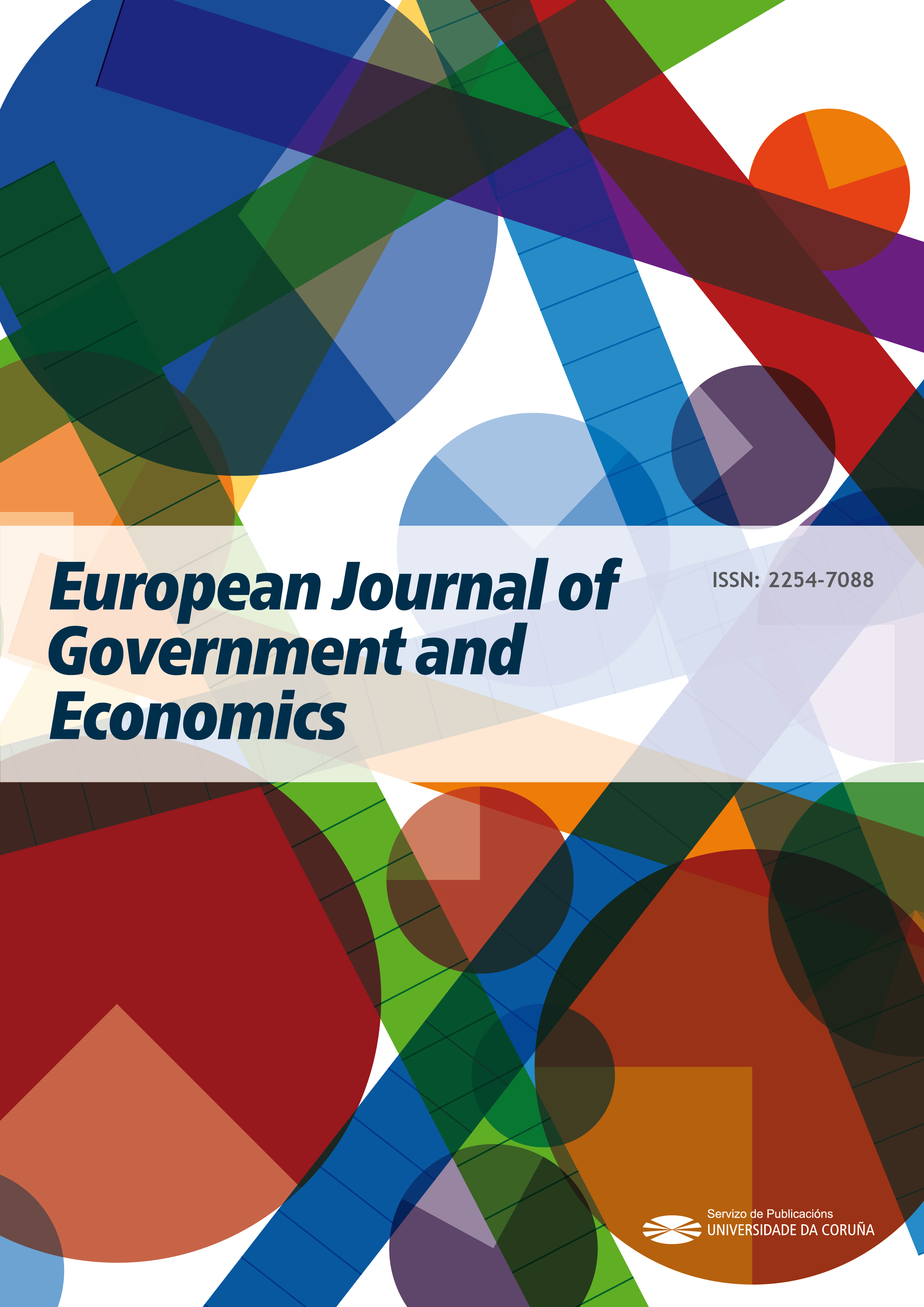A comparative analysis of the European Union member states in terms of public spending on environmental protection in 2004-2017
Main Article Content
Abstract
The main purpose of the paper is to present the results of the comparative analysis of the member states of the European Union in terms of expenditure on environmental protection made by the public sector. An additional purpose of the paper is to verify whether there is convergence in public spending on environmental protection of the member states of the European Union. In the study, the convergence models and cluster analysis were used. The research results indicate, among others, that there was convergence in total public spending on environmental protection in the member states of the European Union in 2004-2017, and that the structure of the member states in terms of amounts of public spending on various aspects of environmental protection in 2004-2010 differed from the structure of the member states determined for the years 2011-2017.
Keywords:
Downloads
Article Details
References
Apergis, N., Christou, C., and Hassapis, C. (2013). Convergence in public expenditures across EU countries: Evidence from club convergence. Economics and Finance Research 1: 45–59. https://doi.org/10.1080/21649480.2013.862735
Barro, R. J., and Sala-i-Martin, X. (1992). Convergence. Journal of Political Economy 100: 223–51. https://doi.org/10.1086/261816
Calinski, T., and Harabasz, J. (1974). A Dendrite Method for Cluster Analysis. Communications in Statistics 3: 1–27. https://doi.org/10.1080/03610917408548446
Charrad, M., Ghazzali, N., Boiteau, V., et al. (2014). NbClust: An R Package for Determining the Relevant Number of Clusters in a Data Set. Journal of Statistical Software 61: 1–36. https://doi.org/10.18637/jss.v061.i06
Davies, D. L. & Bouldin, D. W. (1979). A Cluster Separation Measure. IEEE Transactions on Pattern Analysis and Machine Intelligence 1: 224–227. https://doi.org/10.1109/TPAMI.1979.4766909
De Simone, E., Gaeta, G. L., and Ercolano, S. (2010). Exploring Convergence in some OECD Public Social Expenditure Trends. MPRA Paper 22496: 2–24.
Ercolano, S., and Romano, R. (2018). Spending for the Environment: General Government Expenditure Trends in Europe. Social Indicators Research 138: 1145–1169. https://doi.org/10.1007/s11205-017-1695-0
European Commission, Living well, within the limits of our planet. 7th EAP – The new general Union Environment Action Programme to 2020. Available from: http://ec.europa.eu/environment/pubs/pdf/factsheets/7eap/en.pdf
European Parliament, Environment Policy: General Principles and Basic Framework. Available from: http://www.europarl.europa.eu/ftu/pdf/en/FTU_2.5.1.pdf
Eurostat, European Commission (2011), Manual on sources and methods for the compilation of COFOG Statistics. Classification of the Functions of Government (COFOG). In: Methodologies and Working papers, Luxembourg: Publications Office of the European Union.
Ferreiro, J., García-Del-Valle, M. T., and Gómez, C. (2010). Social preferences and fiscal policies: an analysis of the composition of public expenditures in the European Union. Journal of Post Keynesian Economics 32: 347–370. https://doi.org/10.2753/PKE0160-3477320302
Ferreiro, J., García-Del-Valle, M. T., and Gómez, C. (2013). An Analysis of the Convergence of the Composition of Public Expenditures in European Union Countries. American Journal of Economics and Sociology 72: 799–825. https://doi.org/10.1111/ajes.12028
Friedman, M. (1992). Do Old Fallacies Ever Die? Journal of Economic Literature 30: 2129–2132.
Gates, A. J., and Ahn, Y.-Y. (2017). The Impact of Random Models on Clustering Similarity. Journal of Machine Learning Research 18: 1–28. https://doi.org/10.1101/196840
Giertz, J.F., and Mehta, S. (1996). Regional Income Trends and Convergence. Institute of Government and Public Affairs, University of Illinois.
Halaskova, R. (2018). Structure of General Government Expenditure on Social Protection in the EU Member States. Montenegrin Journal of Economics 14: 007–021. https://doi.org/10.14254/1800-5845/2018.14-4.1
Hartigan, J. A., and Hartigan, P. M. (1985). The dip test of unimodality. The Annals of Statistics 13: 70–84. https://doi.org/10.1214/aos/1176346577
Hubert, L. & Arabie, P. (1985). Comparing partitions. Journal of Classification 2: 193–218. https://doi.org/10.1007/BF01908075
Kassambara, A., and Mundt, F. (2017). factoextra: Extract and Visualize the Results of Multivariate Data Analyses. R package version 1.0.5. Available from: https://CRAN.R-project.org/package=factoextra
Krzanowski, W. J., and Lai, Y. T. (1988). A Criterion for Determining the Number of Groups in a Data Set Using Sum-of-Squares Clustering. Biometrics 44: 23–34. https://doi.org/10.2307/2531893
Leitner, S., and Stehrer, R. (2016). Development of Public Spending Structures in the EU Member States: Social Investment and its Impact on Social Outcomes. Working paper 128, The Vienna Institute for International Economic Studies, Vienna.
Murtagh, F., and Legendre, P. (2014). Ward’s Hierarchical Agglomerative Clustering Method: Which Algorithms Implement Ward’s Criterion? Journal of Classification 31: 274–295. https://doi.org/10.1007/s00357-014-9161-z
Phillips, P. C. B., and Sul, D. (2007). Transition modeling and econometric convergence tests. Econometrica 75: 1771–1855. Doi: https://doi.org/10.1111/j.1468-0262.2007.00811.x
Pitlik, H. & Schratzenstaller, M. (2011). Growth Implications of Structure and Size of Public Sectors. WIFO Working Papers 404.
Quah, D. (1993). Galton's Fallacy and Tests of the Convergence Hypothesis. The Scandinavian Journal of Economics 95: 427–443. https://doi.org/10.2307/3440905
Rand, W. M. (1971). Objective criteria for the evaluation of clustering methods. Journal of the American Statistical Association 66: 846–850. https://doi.org/10.1080/01621459.1971.10482356
Rousseeuw, P. (1987). Silhouettes: A Graphical Aid to the Interpretation and Validation of Cluster Analysis. Journal of Computational and Applied Mathematics 20: 53–65. https://doi.org/10.1016/0377-0427(87)90125-7
Russu, C. (2017). Progress and Dysfunctionalities in Environmental Protection in Romania. Economic Insights – Trends and Challenges VI: 37–44.
Ryu, D. (2015). Fiscal Spending and Economic Growth. Journal of Economic Development 40: 91–105. https://doi.org/10.35866/caujed.2015.40.4.004
Sokołowski, A., Denkowska, S., and Fijorek, K. (2019). The assessment of selected measures for clustering quality. In: Vision 2025: Education Excellence and Management of Innovations through Sustainable Economic Competitive Advantage: Proceedings, ed. Khalid S. Soliman - King of Prussia, PA: International Business Information Management Association (IBIMA), p. 10033–10042.
Szarowska, I. (2011). Relationship between government spending and economic growth in the Czech Republic. Acta Universitatis Agriculturae et Silviculturae Mendelianae Brunensis LIX: 415–422. https://doi.org/10.11118/actaun201159070415
Ward, J. H. (1963). Hierarchical Grouping to Optimize an Objective Function. Journal of the American Statistical Association 58: 236–244. https://doi.org/10.1080/01621459.1963.10500845
Wilcoxon, F. (1945). Individual comparisons by ranking methods. Biometrics Bulletin 1: 80–83. https://doi.org/10.2307/3001968







